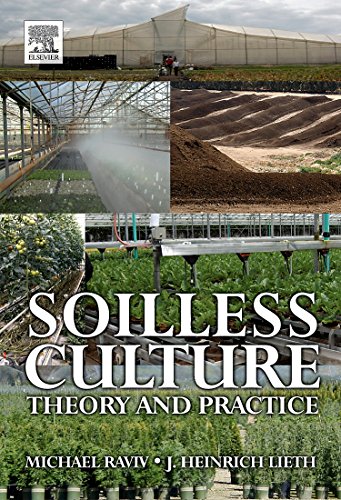
Title : Soilless Culture: Theory and Practice 1st Edition
Author : Michael Raviv, Heiner Lieth, Asher Bar-Tal
Publisher : Elsevier Science; 1st edition (December 31, 2007)
Language : English
Hardcover : 608 pages
ISBN : 0444529756
Plant production in hydroponics and soilless culture is rapidly expanding throughout the world, raising a great interest in the scientific community. For the first time in an authoritative reference book, authors cover both theoretical and practical aspects of hydroponics (growing plants without the use of soil). This reference book covers the state-of-the-art in this area, while offering a clear view of supplying plants with nutrients other than soil. Soilless Culture provides the reader with an understanding of the properties of the various soiless media and how these properties affect plant performance in relation to basic horticultural operations, such as irrigation and fertilization. This book is ideal for agronomists, horticulturalists, greenhouse and nursery managers, extension specialists, and people involved with the production of plants. (Elsevier.com)
Table of Contents
List of Contributors
Preface
1 Significance of Soilless Culture in Agriculture
1.1 Historical Facets of Soilless Production
1.2 Hydroponics
1.3 Soilless Production Agriculture
References
2 Functions of the Root System
2.1 The Functions of the Root System
2.2 Depth of Root Penetration
2.3 Water Uptake
2.4 Response of Root Growth to Local Nutrient Concentrations
2.5 Interactions Between Environmental Conditions and Form of N Nutrition
2.6 Roots as Source and Sink for Organic Compounds and Plant Hormones
References
Further Readings
3 Physical Characteristics of Soilless Media
3.1 Physical Properties of Soilless Media
3.2 Water Content and Water Potential in Soilless Media
3.3 Water Movement in Soilless Media
3.4 Uptake of Water by Plants in Soilless Media and Water Availability
3.5 Solute Transport in Soilless Media
3.6 Gas Transport in Soilless Media
References
4 Irrigation in Soilless Production
4.1 Introduction
4.2 Root Zone Moisture Dynamics
4.3 Irrigation Objectives and Design Characteristics
4.4 Irrigation Delivery Systems
4.5 Irrigation System Control Methods
4.6 Irrigation Decisions
4.7 Approaches to Making Irrigation Decisions
4.8 Future Research Directions
References
5 Technical Equipment in Soilless Production Systems
5.1 Introduction
5.2 Water and Irrigation
5.3 Production Systems
5.4 Examples of Specific Soilless Crop Production Systems
5.5 Discussion and Conclusion
References
6 Chemical Characteristics of Soilless Media
6.1 Charge Characteristics
6.2 Specific Adsorption and Interactions Between Cations/Anions and Substrate Solids
6.3 Plant-induced Changes in the Rhizosphere
6.4 Nutrient Release from Inorganic and Organic Substrates
References
7 Analytical Methods Used in Soilless Cultivation
7.1 Introduction
7.2 Physical Analysis
7.3 Methods
7.4 Chemical Analysis
7.5 Biological Analysis
References
8 Nutrition of Substrate-grown Plants
8.1 General
8.2 Nutrient Requirements of Substrate-grown Plants
8.3 Impact of N Source
8.4 Integrated Effect of Irrigation Frequency and Nutrients Level
8.5 Salinity Effect on Crop Production
8.6.1 pH Manipulation
8.6.2 Salinity Control
References
9 Fertigation Management and Crops Response to Solution Recycling in Semi-closed Greenhouses
9.1 System Description
9.2 Management
9.3 Specific Crops Response to Recirculation
9.4 Modeling the Crop-Recirculation System
9.5 Outlook: Model-based Decision-support Tools for Semi-Closed Systems
Acknowledgment
Appendix
References
10 Pathogen Detection and Management Strategies in Soilless Plant Growing Systems
10.1 Introduction
10.2 Detection of Pathogens
10.3 Microbial Balance
10.4 Disinfestation of the Nutrient Solution
10.5 Synthesis: Combined Strategies
Acknowledgments
References
11 Organic Soilless Media Components
11.1 Introduction
11.2 Peat
11.3 Coir
11.4 Wood Fiber
11.5 Bark
11.6 Sawdust
11.7 Composted Plant Waste
11.8 Other Materials
11.9 Stability of Growing Media
11.10 Disease Suppression by Organic Growing Media
References
12 Inorganic and Synthetic Organic Components of Soilless Culture and Potting Mixes
12.1 Introduction
12.2 Most Commonly Used Inorganic Substrates in Soilless Culture
12.3 Most Commonly Used Synthetic Organic Media in Soilless Culture
12.4 Substrates Mixtures — Theory and Practice
12.5 Concluding Remarks
Acknowledgments
References
13 Growing Plants in Soilless Culture: Operational Conclusions
13.1 Evolution of Soilless Production Systems
13.2 Development and Change of Soilless Production Systems
13.3 Management of Soilless Production Systems
References
Index of Organism Names
Subject Index
